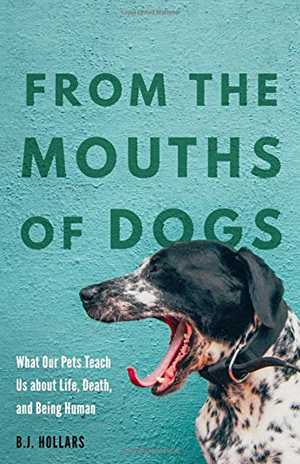[alert variation=”alert-info”]Publisher: University of Nebraska Press
Formats: Hardcover, eBook, Kindle
Purchase: Powell’s | Amazon | IndieBound | Barnes & Noble | iBooks[/alert]
This book is for animal lovers, particularly dog lovers. It is best described as a combination of ethnographic memoir and sincere revelation of what dogs can do for us and what dogs and humans can learn from each other. B.J. Hollars is a creative writer who has a deep and abiding love for ‘man’s best friend,’ and an innate skill for conducting empathetic research seeking lessons to learn and to live by. In fact, the book’s 10 chapters are divided evenly into those two parts: I‒Lessons Learned, with chapter titles like ‘Sniffing for Trouble,’ ‘Old Dogs, New Shticks,’ and ‘I Left My Heart in Hartsdale’; and II‒Lessons Lived, with titles like ‘Bingo Was Her Name,’ ‘The Bionic Dog,’ and ‘Travels with Sandy.’
The book’s frontispiece is a photo of Hollars as a small boy with Sandy, his beloved dog. Several times in the book, he refers back to his affection for Sandy, who passed on years ago. But, it took him many years and the writing of this book before Hollars finally put the ashes of his childhood companion to rest, at the end of the story.
In the prologue, the author describes himself “not as a scientist, sociologist, or animal behaviorist, but as a humble writer and avid dog walker” who wonders what lessons can be gleaned from the dog at the end of the leash. And, he writes, “while this book may masquerade as a narrative on the human-animal bond, make no mistake, my primary interest remains with the humans. What can pets teach us? Or, to put it differently: what can we learn when we listen?”
Along the way he’s attentive to both dog and human behavior of all kinds, and how they interact. He pulls no punches and tells it like it is, about the lives and times of dogs and of their human caretakers (or is it the other way around?).
As we travel with B.J. Hollars around America’s upper Midwest and the East, he introduces us to a range of provocative issues, including dog rescue and contemporary pet care, animal cruelty, prosthetic devices for disabled pets, the pet industry in contemporary society and the economy, pet population statistics, how dogs impact human well-being and health, pet cemeteries, and the inspiration that our pets – especially dogs – give us.
Under how pets affect our general well being, he writes that owning a pet “appears to benefit virtually all people in some manner,” particularly seniors. Having a dog around, he says can “provide far more than a boost in morale; scientifically speaking, they boost the immune system as well. Recent studies have linked petting a dog with a drop in blood pressure, and owning one has the potential to fortify the heart, lower cholesterol, even help fight depression.”
On the flip side of the coin, meet Bruiser, a seriously impaired dog needing physical, emotional and moral support from his human companions. Bruiser suffers from bilateral elbow dysplasia; in short, he can’t walk. Under normal circumstances Bruiser would probably have been put down as a helpless cripple. But he wasn’t. Instead, he’s a cherished pet of proud owners.
So, how does he get around? – on the ‘Bruiser Cruiser,’ a device with wheels on which he has learned to scoot about.
His owners tell the book’s author some of the great lessons that Bruiser has taught them. One is “that you can’t believe in can’t… You have to be willing to try. Bruiser has more spunk and more spirit and more drive than most dogs.” And when people meet Bruiser they see a dog who can and does, and who silently tells us: “See me for what I am and not for what I have.”
The lesson learned by Bruiser’s story is No.3 in the book: ‘Don’t Believe in Can’t.” Some other lessons highlighted by the stories in this book are ‘Live Your Life with Hope,’ ‘Be Positive,’ and ‘Help Others Any Way You Can.’
This inspiring study is recommended for animal lovers, and for lovers of life in general.
[signoff predefined=”Social Media Reminder” icon=”facebook”][/signoff]

